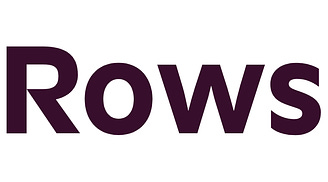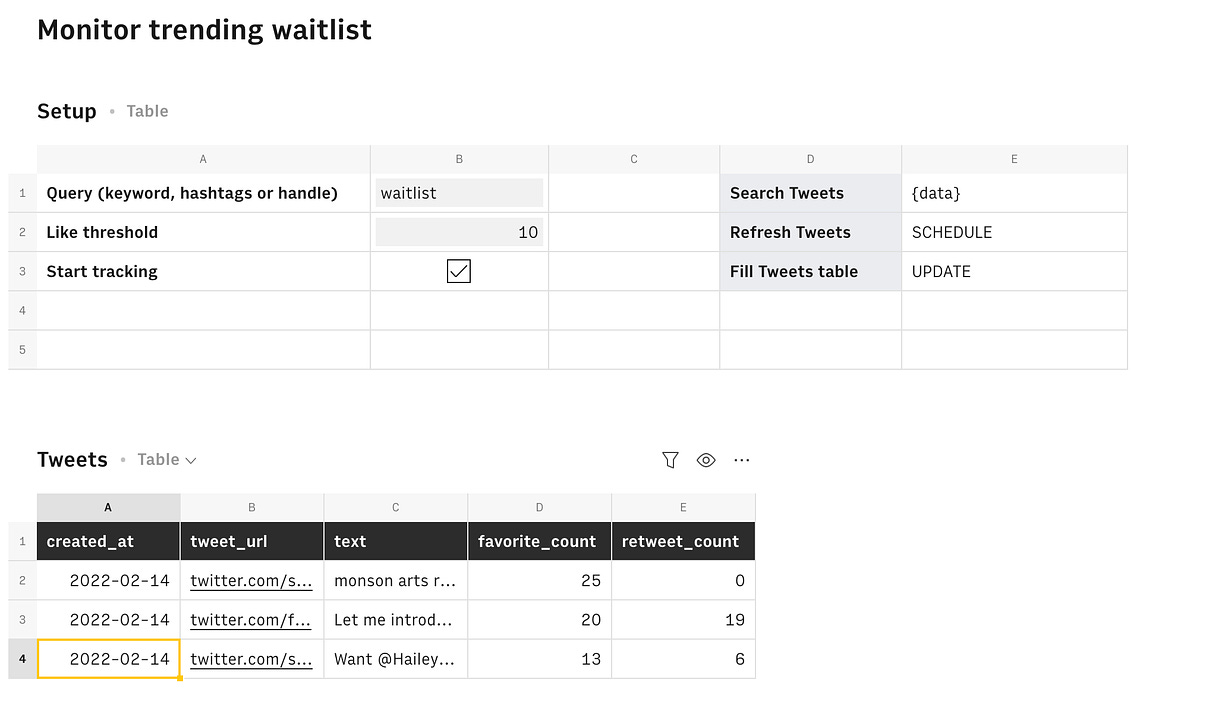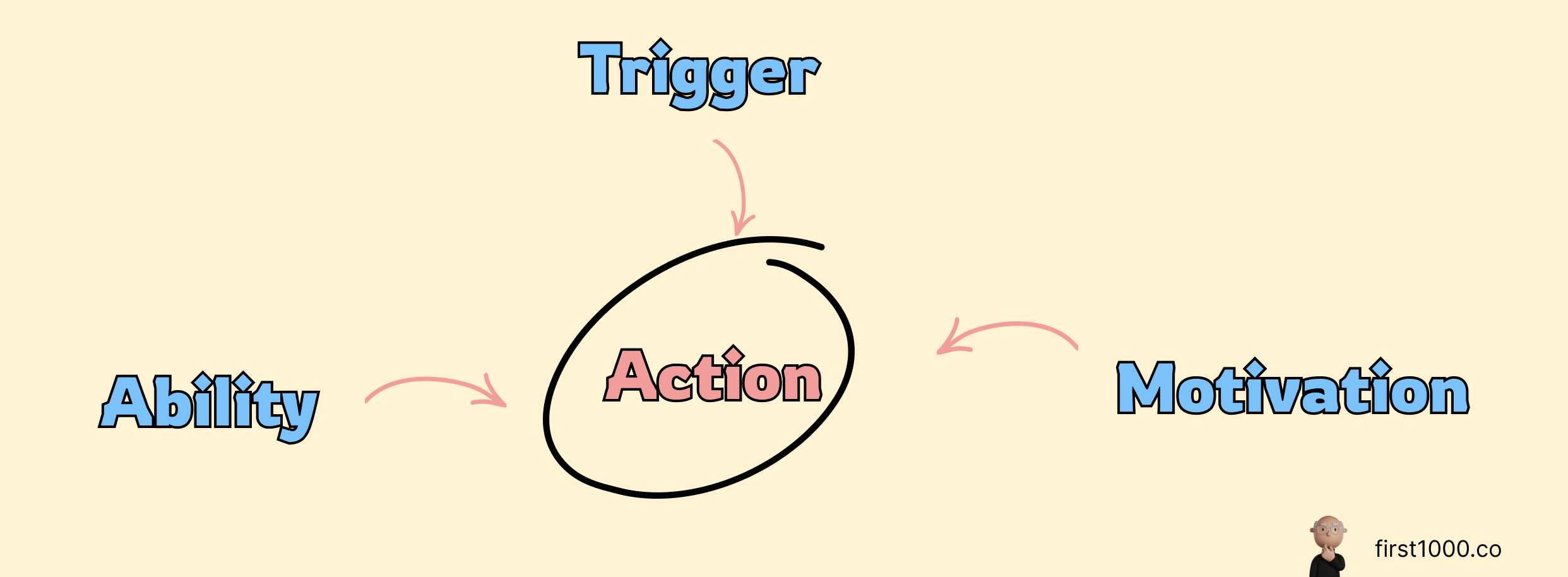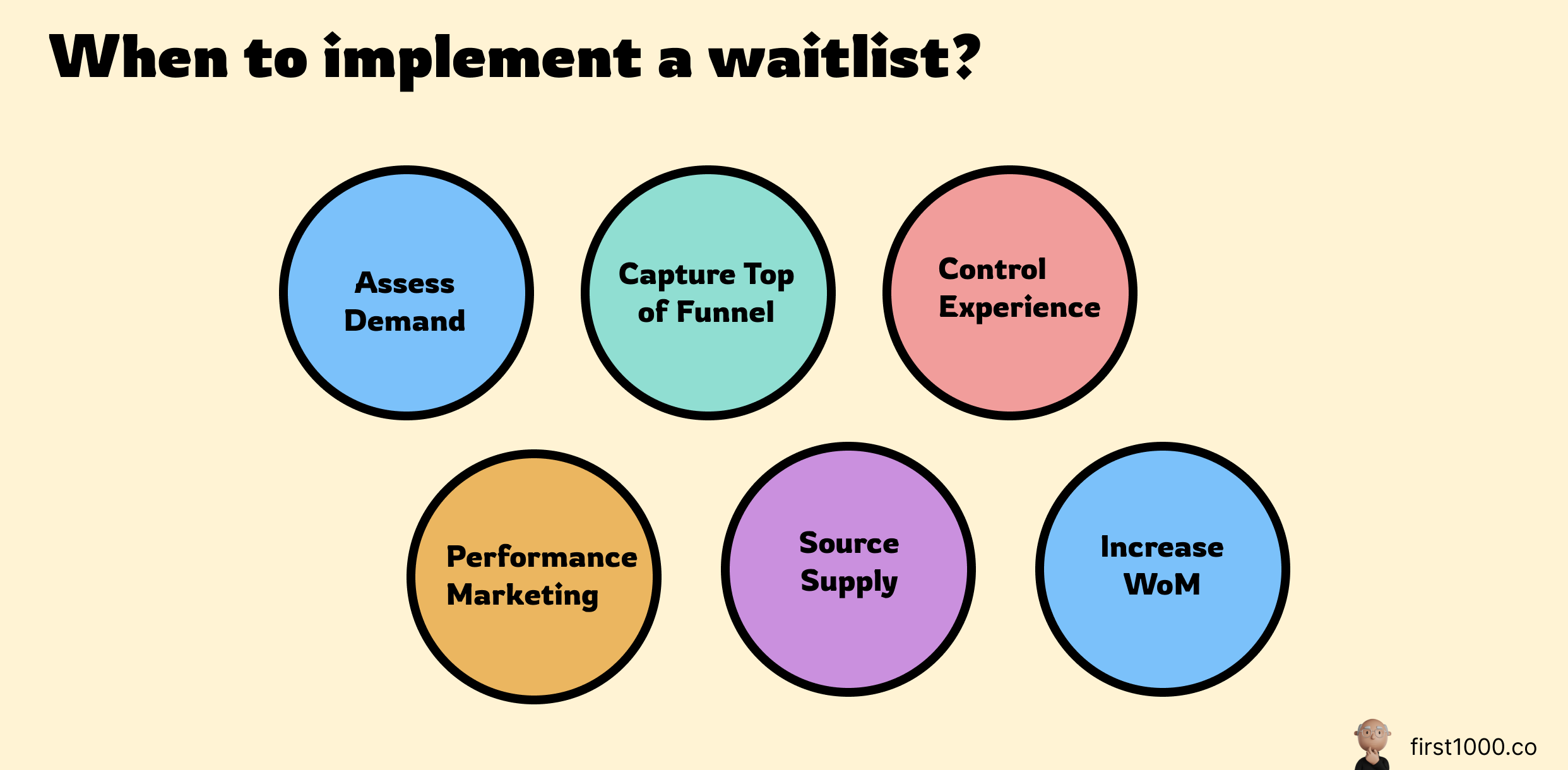First 1000 - 🕖Waitlists
If this was forwarded your way and you wish to sign up to First 1000, you can do so here :) 🕖WaitlistsWhat makes a successful waitlist program + when does it even make sense to implement a waitlist?
Today’s issue is brought to you by Rows Rows is a spreadsheet with superpowers. It has cells and functions you already know, but it also has integrations with 40+ business tools like Hubspot and Mailchimp and public databases like Crunchbase and LinkedIn. It's like if Excel, Airtable, and Zapier had a baby. I use it to track the growth of this newsletter, but you can also use it to enrich and verify mailing lists, track crypto with email & Slack alerts, create Google Analytics dashboards, and many, many more. Oh, I forgot to mention you can even connect your custom API to build internal tools and streamline your operations. Save hours of manual work and wave goodbye scripts and add-ons. Rows also made sharing your spreadsheets 100x better. With Live sharing, you can build interactive dashboards, forms, reports and collaborate with others without risking your formulas being messed up. Experiment with Rows to make your teamwork faster. Hello Frens 👋, Happy Tuesday! I have wanted to write about waitlists for some time now, but I never really got the chance to until this week. I am excited! I even built a little Trending Waitlist tracker to ensure I never miss out on the next big thing.
My motivation for writing this piece comes from observing my own behavior; my reaction to a waitlist has always been extreme. I either go crazy to get access to products during their invite-only phase. For instance, I donated $50 x 3 for a chance to “win” a Clubhouse invite, I wrote a handwritten snail mail begging the founder of a certain productivity app to give me access and, of course, did the whole referral thing, getting people to sign up to get earlier access...many many times. I took the time this week to reflect not just on why that is the case, but more importantly, study the extremely successful, kind-of-successful, and flops of the waitlist world. My goal is to come out of this research with a better understanding of why I act the way I do, what makes a successful waitlist program and when it makes sense to implement a waitlist? — Why it works: The Psychology behind waitlists:
People take action when three forces collide:
Waitlists play on all three forces to varying degrees. The motivation lever is obvious; people mimic the desires of people they look up to desire— oftentimes without a rational grounding. $13.9 billion was spent on influencer marketing last year alone. In that context, the motivation for signing up to a waitlist changes from a personal need or a pain point to seeking a higher status or social capital from our group by being on the same new app as Marc Andreessen or using the same recovery tracker as Michael Phelps or wearing the same sneakers as Alexis Ohanian. I am guilty of all three. Every time the same new hot app is shared by someone I know or respect — whether a friend, a mega-influencer or someone in between — I am reminded of my desire to belong to the elite group of people with access. The scarcer a thing is, the higher the status from being associated with it and the stronger my bias to action. I’ll do whatever it takes, and if you know me, I mean that in a literal sense! The ability front is more subtle. For a waitlist specifically, the ability to access a certain product directly contradicts the motivation to sign up in the first place. The more access people, the less status is associated with having one. It is the typical “I Don’t Want to Belong to Any Club That Will Accept Me as a Member.” Waitlists are hard to pull off; make it too easy, and people lose motivation, make it too hard, and people also lose motivation. It has to be just hard enough! When to implement a waitlistDuring my many desperate attempts trying to get off waitlists, the answer I get when asking if I could get into the coveted group of early users is, “we are not trying to be exclusive; we want to ...” And that is true. There are many reasons for implementing a waitlist beyond building hype or generating demand or whatever we are calling it these days. From looking into ~30 of the most successful implementation of waitlists, I found these 6 broad categories as being the main driver behind implementing a waitlist. I talked to 4 of these founders, but the vast majority is driven by research. If there is anything I know for sure, what people publicly acknowledge is a clouded distorted version of reality. So as always, take everything I say with a grain of salt!
When it is costly to build an MVP, a landing page + waitlist is true, and tried strategy to launch and get quick feedback before investing more resources. I use the term costly a little bit liberally here. I don’t mean costly strictly in terms of capital, but also time and effort needed to deliver an MVP. When entering a crowded space, the threshold for an acceptable MVP from a consumer perspective is vastly different from when operating in a new product category with a different business model and/or mode of operations.
Related but different to assessing demand is capturing low intent customers. This is the case when working in a domain that has a high price point, requires a high trust threshold and/or a meaningful investment in customer education. For many companies that fall into one of those three categories, waitlists are a way to capture low intent customers and convert them by overcoming the main obstacle over time*.* Waitlists here run for many years!
Getting feedback and developing the right product experience is a commonly cited reason why a certain product has gated access. This is especially true for consumer products where losing 75% of the initial sign-ups is considered a good retaining product. A waitlist, in that case, helps the team from getting pulled in too many directions or serving too many masters. After the company finds product-market fit and has a sticky product experience in this category, the waitlist is often retired.
Sometimes waitlists are implemented for purely tactical reasons. This is the case for companies that leverage waitlists to improve conversion and, subsequently, the unit economics of performance marketing. I found community-based advertising (advertising on podcasts, newsletters, Facebook groups, slack communities, or even influencer marketing) being the most common avenue for this kind of “Skip the line because you are one of us” messaging, although it was still present on more traditional channels as Facebook, Instagram..etc.
Sourcing Supply is another common avenue for implementing a waitlist. For bootstrapping liquidity on a multi-sided marketplace, waitlists effectively capture demand and sourcing supply as needed to allow the demand and supply side of the network to grow in lockstep.
And finally, the most dangerous of them all: implementing a waitlist to increase word of mouth. I am yet to find a product that exclusively implemented a waitlist successfully to generate word of mouth. However, I suspect that people were at least partially motivated by the virality potential of successful waitlist product launches: the Gmail(s), Dropbox(es), Robinhood(s) of the world. One does not have to go exclusively one way or the other. For instance, HMBradley — the digital banking platform that develops programs to reward savers— shifted to a waitlist model to control user experience after seeing a strong market pull for a new product. A few months later, they shifted their marketing to “Skip the waitlist” and have since used waitlists to test demand for new products. There is no reason not to extract the tangential value from implementing a waitlist. It is the smart thing to do! Growing a waitlistThe straightforward way to grow a waitlist is to have more people on the waitlist. This is clearly problematic. During my research process, I found a few interesting ways to get a waitlist off the ground.
From Indie Hackers
Instead of filling out a form to get on HEY's waitlist, those who wanted access had to send them an email. Seeing HEY's overwhelming success with this approach, Alex Hillman of Indy Hall decided to give it a shot with his new book, Tiny MBA. He put out a few posts on social media inviting people to email him if they were interested in the book, and within 24 hours, 90 people had contacted him requesting a pre-sale link. That's 25-40% of the people who liked his posts. In addition to creating demand, this made it easy for him to nurture his relationship with each potential customer, increasing the likelihood of conversion. And then there's all the time he saved — he didn't even have to build a landing page. Friction works in mysterious ways. On the one side, the more steps users need to go through in a checkout flow, the higher the chances someone drops off. On the other hand, the sunk cost fallacy tells us that people are more likely to follow through on an endeavor if they have already invested time, effort, or money. Introducing a little friction to the waitlist can increase its perceived value and make people more motivated to get their hands on the product.
Videos are one of the cornerstones to generating buzz. And product demos are a good starting point. I found two particular kinds of demos that successfully broke through the noise and generated interest in a products waitlist, although I am sure other formats would work just as well. The Demo that shows too much This is the kind of demo that hypes people about a world where the product exists and how it will make the world better. This is for the technically impressive, never seen before kind of products. PianoVision, an Oculus AR Piano learning app, is a great demonstration of this concept. Developed by an Indie creator, Zac Reid, who barely had any following before releasing the video on Twitter. The video generated 30,000+ views and bootstrapped the waitlist for the new app.   The Demo that Shows too little The demo that shows too little is on the other end of the spectrum. It works by creating a mystique around the product in question and tapping into our reptile curious brains to learn more (i.e., join the waitlist). The example I use here is from Rift Finance. The video does not demonstrate anything about the product or literally anything to that extent. It captures the essence of what Rift is trying to accomplish in a manner captivating enough that the bet is people would go to the website to learn more. The waitlist hit 25,000 members in 24 hours. There are many forces at play here, a passionate discord community, high-profile prospective customers..etc. However, I like to think the video had a thing or two in the smashing success of the waitlist launch. I am just scratching the surface here on how to build and grow a waitlist. Admittedly, I did not spend much of my time here, but I thought these few examples were worth sharing. For part 2 next week, I am doubling down on building and growing a waitlist. How to get a waitlist from 0→10→1000→🚀🌜. Send in your favorite examples 👇🏽. I will feature the best ones!  Until we meet again 😉, I am testing out a new referral program for the newsletter, still in beta but you can check it out here. |
Older messages
Brute Forcing Your Way to “Default Alive”
Tuesday, February 8, 2022
Guest Post by Ruchin Kulkarni from Toplyne
🚵♀️ Strava
Tuesday, February 1, 2022
& the Inch Wide Mile Deep go to market
GTM Canon
Tuesday, January 18, 2022
The best GTM content from around the internet
🤷♀️The Trust Paradox
Tuesday, January 11, 2022
How did startups with businesses anchored on overcoming a large threshold of trust acquire early customers when they have no track record to fall back on?
✨Notion
Tuesday, December 14, 2021
+ launching a product in a crowded space, growing through Word of Mouth and positioning a product that is hard to explain!
You Might Also Like
🚀 Ready to scale? Apply now for the TinySeed SaaS Accelerator
Friday, February 14, 2025
What could $120K+ in funding do for your business?
📂 How to find a technical cofounder
Friday, February 14, 2025
If you're a marketer looking to become a founder, this newsletter is for you. Starting a startup alone is hard. Very hard. Even as someone who learned to code, I still believe that the
AI Impact Curves
Friday, February 14, 2025
Tomasz Tunguz Venture Capitalist If you were forwarded this newsletter, and you'd like to receive it in the future, subscribe here. AI Impact Curves What is the impact of AI across different
15 Silicon Valley Startups Raised $302 Million - Week of February 10, 2025
Friday, February 14, 2025
💕 AI's Power Couple 💰 How Stablecoins Could Drive the Dollar 🚚 USPS Halts China Inbound Packages for 12 Hours 💲 No One Knows How to Price AI Tools 💰 Blackrock & G42 on Financing AI
The Rewrite and Hybrid Favoritism 🤫
Friday, February 14, 2025
Dogs, Yay. Humans, Nay͏ ͏ ͏ ͏ ͏ ͏ ͏ ͏ ͏ ͏ ͏ ͏ ͏ ͏ ͏ ͏ ͏ ͏ ͏ ͏ ͏ ͏ ͏ ͏ ͏ ͏ ͏ ͏ ͏ ͏ ͏ ͏ ͏ ͏ ͏ ͏ ͏ ͏ ͏ ͏ ͏ ͏ ͏ ͏ ͏ ͏ ͏ ͏ ͏ ͏ ͏ ͏ ͏ ͏ ͏ ͏ ͏ ͏ ͏ ͏
🦄 AI product creation marketplace
Friday, February 14, 2025
Arcade is an AI-powered platform and marketplace that lets you design and create custom products, like jewelry.
Crazy week
Friday, February 14, 2025
Crazy week. ͏ ͏ ͏ ͏ ͏ ͏ ͏ ͏ ͏ ͏ ͏ ͏ ͏ ͏ ͏ ͏ ͏ ͏ ͏ ͏ ͏ ͏ ͏ ͏ ͏ ͏ ͏ ͏ ͏ ͏ ͏ ͏ ͏ ͏ ͏ ͏ ͏ ͏ ͏ ͏ ͏ ͏ ͏ ͏ ͏ ͏ ͏ ͏ ͏ ͏ ͏ ͏ ͏ ͏ ͏ ͏ ͏ ͏ ͏ ͏ ͏ ͏ ͏ ͏ ͏ ͏ ͏ ͏ ͏ ͏ ͏ ͏ ͏ ͏ ͏ ͏ ͏ ͏ ͏ ͏ ͏ ͏ ͏ ͏ ͏ ͏ ͏ ͏ ͏ ͏ ͏ ͏ ͏ ͏ ͏
join me: 6 trends shaping the AI landscape in 2025
Friday, February 14, 2025
this is tomorrow Hi there, Isabelle here, Senior Editor & Analyst at CB Insights. Tomorrow, I'll be breaking down the biggest shifts in AI – from the M&A surge to the deals fueling the
Six Startups to Watch
Friday, February 14, 2025
AI wrappers, DNA sequencing, fintech super-apps, and more. ͏ ͏ ͏ ͏ ͏ ͏ ͏ ͏ ͏ ͏ ͏ ͏ ͏ ͏ ͏ ͏ ͏ ͏ ͏ ͏ ͏ ͏ ͏ ͏ ͏ ͏ ͏ ͏ ͏ ͏ ͏ ͏ ͏ ͏ ͏ ͏ ͏ ͏ ͏ ͏ ͏ ͏ ͏ ͏ ͏ ͏ ͏ ͏ ͏ ͏ ͏ ͏ ͏ ͏ ͏ ͏ ͏ ͏ ͏ ͏ ͏ ͏ ͏ ͏ ͏ ͏ ͏ ͏ ͏ ͏ ͏
How Will AI-Native Games Work? Well, Now We Know.
Friday, February 14, 2025
A Deep Dive Into Simcluster ͏ ͏ ͏ ͏ ͏ ͏ ͏ ͏ ͏ ͏ ͏ ͏ ͏ ͏ ͏ ͏ ͏ ͏ ͏ ͏ ͏ ͏ ͏ ͏ ͏ ͏ ͏ ͏ ͏ ͏ ͏ ͏ ͏ ͏ ͏ ͏ ͏ ͏ ͏ ͏ ͏ ͏ ͏ ͏ ͏ ͏ ͏ ͏ ͏ ͏ ͏ ͏ ͏ ͏ ͏ ͏ ͏ ͏ ͏ ͏ ͏ ͏ ͏ ͏ ͏ ͏ ͏ ͏ ͏ ͏ ͏ ͏ ͏ ͏ ͏ ͏ ͏ ͏ ͏ ͏ ͏ ͏ ͏ ͏ ͏ ͏ ͏





